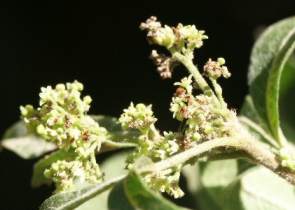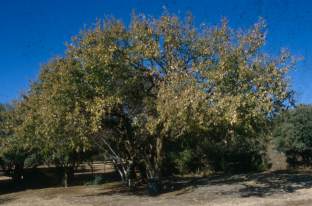Searsia pyroides
Searsia pyroides (Burch.) Moffett
Family: Anacardiaceae
Common names: common wild currant, fire-thorn karree (Eng.); gewone taaibos (Afr); motshakhutshakhu (North Sotho); koditshane (South Sotho); mogodiri (Tswana); mutasiri (Venda); inHlokoshiyane (Zulu); ntlokotshane (Xhosa)
SA Tree No: 392
Introduction
To the gardener who likes variety in the garden, Searsia pyroides should not be left out. This is a good species to provide textural variation in your garden. You will not be alone in choosing this tree as it has been chosen as the Tree of the Year for 2007 together with Pavetta schumanniana.

Description
Description
This is a deciduous shrub or a small to medium-sized, multistemmed tree, frequently with spines. The bark is rough and grey. The leaves are compound, composed of three leaflets (tri-foliate). The leaves are borne on slender stalks, which are furrowed above. The leaflets are oval, narrowing at both ends, sometimes with a short tip. The largest leaflets are up to 70 x 30 mm with a round or a flat tip. They are smooth or velvety above, the lower surface is usually slightly hairy. The midrib and the secondary veins are conspicuous and raised below.

The flowers are inconspicuous and greenish in branched bunches in the axils of the leaves and at the end of the branches.

The fruits ripen in summer to late autumn. They are borne in such quantities that the branches bend with the weight. The fruits are round and small, white and red when ripe.

Conservation Status
Status
It is not protected by any legislation.
Distribution and habitat
Distribution description
Searsia pyroides is widely distributed all over South Africa and beyond the borders to Botswana and Namibia. It grows along rivers, on ironstone hills, in open bush, on forest verges, in valleys and in open grassland.
Derivation of name and historical aspects
History
Searsia pyroides was first collected by Burchell on the Asbestos Mountains in the Northern Cape. His specimen is still preserved at the Royal Botanic Gardens, Kew in London. The genus Searsia was named after Paul B. Sears (1891-1990) who was head of the Yale School of Botany. The specific epithet pyroides is from the Greek word, pyros, meaning fire and refers to the burning sensation caused by a prick from the thorns.
The Anacardiaceae family is widespread in warmer parts of the world with about 91 taxa of Searsia occurring in southern Africa.
Ecology
Ecology
Searsia pyroides is ecologically important in South Africa as are many other species in this genus. As it is found in many vegetation types, it plays a role as a pioneer species in the cycle of plant succession. Birds are particularly fond of the fruits. Wattled Starling and Red-eyed Bulbuls have been seen gorging on them. Elephant, impala and kudu eat shoots and young leaves.

Uses
Use
The wood is used to make hoe handles. The branches are used to build kraals. The fruit is edible, with a pleasant, sweet-acidic taste. As herdboys we used to enjoy fruit from the wild, among those were Searsia pyroides, Scolopia mundii, Grewia occidentalis and Ziziphus mucronata.
This is a wonderfully decorative tree in a garden. It can also be used as a hedge.
Growing Searsia pyroides
Grow
Searsia pyroides is not yet popular as a garden plant and needs to be promoted in the gardening fraternity. The male and female flowers are produced from different plants. According to Ernst van Jaarsveld, Kirstenbosch horticulturist, this tree is easily grown from seed. Sow the seeds in a well-balanced soil mix and they will germinate in three weeks. Seeds are not susceptible to any fungal infection. It is a hardy, frost-resistant plant and is well suited to highveld gardens. This is a bushy plant that takes pruning well when treated as a shrub.
References
- Palmer, E. & Pitman, N. 1972. Trees of southern Africa. Balkema, Cape Town.
- Moffett, R.O. 2007. Name changes in the Old World Rhus and recognition of Searsia (Anacardiaceae). Bothalia 37(2):165-175
- Moffett, R.O. 1993. Rhus. Anacardiaceae. Flora of southern Africa 19, part 3, fasc. 1. National Botanical Institute, Pretoria.
- Van Wyk, A.E. (Braam) & Van Wyk, P. 1997. Field guide to trees of southern Africa. Struik, Cape Town
Credits
Giles Mbambezeli
Kirstenbosch National Botanical Garden
February 2007
Updated July 2008
Plant Attributes:
Plant Type: Tree
SA Distribution: Eastern Cape, Free State, Gauteng, KwaZulu-Natal, Limpopo, Mpumalanga, North West, Northern Cape, Western Cape
Soil type:
Flowering season: Early Summer
PH:
Flower colour: Green
Aspect: Full Sun
Gardening skill: Easy
Special Features:
Horticultural zones











Rate this article
Article well written and informative
Rate this plant
Is this an interesting plant?
Login to add your Comment
Back to topNot registered yet? Click here to register.